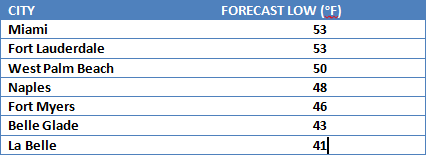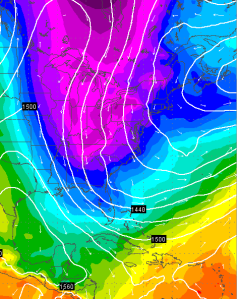Good Sunday evening south Florida. Here’s the latest weather outlook for the upcoming week, which promises some interesting weather to begin Spring 2013.
SYNOPSIS
It goes without question that this past weekend was characterized by the unseasonably hot temperatures and humid conditions. In fact, Miami International Airport (KMIA) reported a high of 90 degrees today, tying the record high for March 24 set back in 1897! Most areas across south Florida maxed out in the mid 80s to low 90s, except the Naples area where the high was a more comfortable 81 degrees, largely aided by the persistent southwesterly (SW) wind flow. So why was it that south Florida was so warm to where it felt quite a lot like summertime?

This was the surface analysis map taken earlier this Sunday morning. It shows that a warm front (located by the red semicircles along Georgia and the Atlantic Waters) has propagated northward (N) across Florida, and that has helped to drag up a considerable mass of maritime tropical (mT) air from the Caribbean waters. Any warm front that moves across the northern hemisphere will allow for the winds to veer (move counterclockwise) from the southeast to the southwest. That wind flow helps to drag in moisture from the Gulf of Mexico, as well as the warmer air witnessed this weekend. At the same time, a cold front extending from the northern Mexican desert to the Florida Panhandle is bringing continental polar (cP) southward from its origins in Canada. This cold front is expected to clear south Florida and usher in colder and VERY dry air across the area (which I will discuss shortly after).
In the meantime, the combination of that warm air rising northward and that cold air sinking southward is helping to generate significant instability across most of the state, with rapidly moving severe thunderstorms across central Florida. These same severe thunderstorms forced the National Weather Service (NWS) forecast office in Melbourne, FL to issue a tornado warning for the Cape Canaveral, FL area earlier this afternoon (although no tornado formed), and the postponement of the final round of the Arnold Palmer Invitational Tournament at Bay Hill, FL until tomorrow morning. The squall line generated today was largely centered over central Florida, primarily north of Lake Okeechobee, before weakening as it headed further south. At this moment, the squall line is quickly weakening, although a light shower is still possible across the east coast metro areas. Also, a large portion of Florida was under a wind advisory today due to the pressure gradient formed by the low pressure system over Georgia. Winds in most areas were sustained at above 20 mph for a majority of the day, which can cause problems for drivers in SUVs or large trucks.
OUTLOOK

The current surface analysis shows that although the storms are ending across Florida, the cold front is lagging well behind, for it is still centered over the Tallahassee region. Nevertheless, it shall continue pushing southward through the overnight hours, and clear the Miami/Fort Lauderdale/Naples area by 11 AM tomorrow. At this time, given the current trends, morning lows across the area will be anywhere from 70-75 degrees. A later arrival of the cold front will allow for temperatures to rise through the morning, while a faster arrival will allow for temperatures to max out shortly after sunrise and steadily fall through the day. Therefore, the guidance consensus goes for the “middle man” estimate of a mid-morning frontal arrival. Surely, winds are expected to start tomorrow out of the W and, once the front DOES move through, winds will veer to out of the NW and begin to enforce the colder air and drying trend. It is possible that high temperatures may reach the low 80s in some areas prior to the frontal passage, but clearing skies will allow for good radiational cooling tomorrow night, and the drop in temperatures will certainly be felt as the night hours pass.

By Tuesday evening, the front will be well south of us and the cold, dry air mass will be in full command. Strong surface high pressure will set up over the Deep South, particularly between Louisiana to Missouri. This orientation of high pressure will drive NW to N winds across the state, leading to clear skies and excellent radiational cooling for Tuesday and Wednesday nights. There is a chance that some areas may experience record low temperatures for this time of year, since late March is not necessarily known for strong cold fronts as this one presents itself to be.

By the latter half of the work week, the high pressure system will build its way out towards the western Atlantic Waters. The surface pressures will begin lowering to seasonal levels, and a slow warming trend will be in store for the weekend as winds will veer to out of the NE and E by Friday afternoon. It is worth noting that although humidities will increase once again by the end of the week, drier air is expected to remain aloft, keeping thunderstorms out of the picture through next week.
Temperature forecasts are located in the graph below. Keep in mind that these forecasts are for the airport locations only. If you are further inland, the temperature may be a few degrees cooler, and vice versa for coastal locations. Also, the forecasts for the latter part of the week are not expected to remain constant, so check my Twitter feed for updated forecasts each day (search @BrianWxFLA).

As you can see, the coldest temperatures are expected between Tuesday morning to Thursday afternoon. Perhaps on Wednesday, temperatures may struggle to reach 70 degrees across the general area. N winds will help to disperse the heating on the ground during the day, and calm winds overnight will allow for excellent radiational cooling, leading to the chilly morning temperatures. Get those jackets out just once more!
For more information and detail into the forecasts, you can view the forecast discussions that the NWS forecast offices put out every morning at these respective links:
NWS Miami: http://forecast.weather.gov/product.php?site=NWS&issuedby=MFL&product=AFD&format=CI&version=1&glossary=1
NWS Melbourne: http://forecast.weather.gov/product.php?site=NWS&issuedby=MLB&product=AFD&format=CI&version=1&glossary=1
NWS Tampa Bay/Ruskin: http://forecast.weather.gov/product.php?site=NWS&issuedby=TBW&product=AFD&format=CI&version=1&glossary=1









































